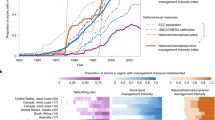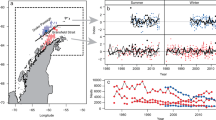Abstract
It is now clear that fished populations can fluctuate more than unharvested stocks. However, it is not clear why. Here we distinguish among three major competing mechanisms for this phenomenon, by using the 50-year California Cooperative Oceanic Fisheries Investigations (CalCOFI) larval fish record. First, variable fishing pressure directly increases variability in exploited populations. Second, commercial fishing can decrease the average body size and age of a stock, causing the truncated population to track environmental fluctuations directly. Third, age-truncated or juvenescent populations have increasingly unstable population dynamics because of changing demographic parameters such as intrinsic growth rates. We find no evidence for the first hypothesis, limited evidence for the second and strong evidence for the third. Therefore, in California Current fisheries, increased temporal variability in the population does not arise from variable exploitation, nor does it reflect direct environmental tracking. More fundamentally, it arises from increased instability in dynamics. This finding has implications for resource management as an empirical example of how selective harvesting can alter the basic dynamics of exploited populations, and lead to unstable booms and busts that can precede systematic declines in stock levels.
This is a preview of subscription content, access via your institution
Access options
Subscribe to this journal
Receive 51 print issues and online access
$199.00 per year
only $3.90 per issue
Buy this article
- Purchase on Springer Link
- Instant access to full article PDF
Prices may be subject to local taxes which are calculated during checkout





Similar content being viewed by others
References
Beddington, J. R. & May, R. M. Harvesting natural populations in a randomly fluctuating environment. Science 197, 463–465 (1977)
May, R. M., Beddington, J. R., Horwood, J. W. & Shepherd, J. G. Exploiting natural populations in an uncertain world. Math. Biosci. 42, 219–252 (1978)
Lande, R., Engen, S. & Saether, B. Stochastic Population Dynamics in Ecology and Conservation (Oxford Univ. Press, New York, 2003)
Murphy, G. I. Vital statistics of the Pacific sardine (Sardinops caerulea) and the population consequences. Ecology 48, 731–736 (1967)
Murphy, G. I. Population biology of the Pacific sardine (Sardine caerulea). Proc. Calif. Acad. Sci. 4th ser. 34, 1–84 (1966)
Marr, J. C. in Proc. World Sci. Meeting Biol. Sardines Related Species (eds Rosa, H. & Murphy, G.) 667–791 (FAO, Rome, 1960)
Clark, F. N. & Marr, J. C. Population dynamics of the Pacific sardine. CalCOFI Prog. Rep. 4, 11–48 (1955)
Rykaczewski, R. R. & Checkley, D. M. Influence of ocean winds on the pelagic ecosystem in upwelling regions. Proc. Natl Acad. Sci. USA 105, 1965–1970 (2008)
Hsieh, C. H. et al. Fishing elevates variability in the abundance of exploited species. Nature 443, 859–862 (2006)
Hunter, J. R. & Lo, N. C. H. Ichthyoplankton methods for estimating fish biomass introduction and terminology. Bull. Mar. Sci. 53, 723–727 (1993)
Gunderson, D. R. Surveys of Fisheries Resources (John Wiley, New York, 1993)
Hsieh, C. H. et al. A comparison of long-term trends and variability in populations of larvae of exploited and unexploited fishes in the southern California region: a community approach. Prog. Oceanogr. 67, 160–185 (2005)
Murphy, G. I. Pattern in life history and the environment. Am. Nat. 102, 391–403 (1968)
Hutchings, J. A. & Reynolds, J. D. Marine fish population collapses: consequences for recovery and extinction risk. BioScience 13, 297–309 (2004)
Hutchings, J. & Baum, J. Measuring marine fishes biodiversity: temporal changes in abundance, life history and demography. Phil. Trans. R. Soc. B 360, 315–338 (2005)
Longhurst, A. The sustainability myth. Fish. Res. 81, 107–112 (2006)
Hsieh, C. H., Reiss, S. C., Hewitt, R. P. & Sugihara, G. Spatial analysis shows fishing enhances the climatic sensitivity of marine fishes. Can. J. Fish. Aquat. Sci. (in the press)
Berkeley, S. A., Hixon, M. A., Larson, R. J. & Love, M. S. Fisheries sustainability via protection of age structure and spatial distribution of fish populations. Fisheries 29, 23–32 (2004)
Jonzen, N., Ripa, J. & Lundberg, P. A theory of stochastic harvesting in stochastic environments. Am. Nat. 159, 427–437 (2002)
Dixon, P. A., Milicich, M. J. & Sugihara, G. Episodic fluctuations in larval supply. Science 283, 1528–1530 (1999)
Hsieh, C. H., Glaser, S. M., Lucas, A. J. & Sugihara, G. Distinguishing random environmental fluctuations from ecological catastrophes for the North Pacific Ocean. Nature 435, 336–340 (2005)
Jonzen, N., Lundberg, P., Cardinale, M. & Arrhenius, F. Variable fishing mortality and the possible commercial extinction of the eastern Baltic cod. Mar. Ecol. Prog. Ser. 210, 291–296 (2001)
Jorgensen, C. et al. Managing evolving fish stocks. Science 318, 1247–1248 (2007)
Lambert, T. C. Duration and intensity of spawning in herring Clupea harengus as related to the age structure of the population. Mar. Ecol. Prog. Ser. 39, 209–220 (1987)
Marteinsdottir, G. & Steinarsson, A. Maternal influence on the size and viability of Iceland cod (Gadus morhua) eggs and larvae. J. Fish Biol. 52, 1241–1258 (1998)
Hutchings, J. A. & Myers, R. A. Effect of age on the seasonality of maturation and spawning of Atlantic cod, Gadus morhua, in the northwest Atlantic. Can. J. Fish. Aquat. Sci. 50, 2468–2474 (1993)
Bobko, S. J. & Berkeley, S. A. Maturity, ovarian cycle, fecundity, and age-specific parturition of black rockfish (Sebastes melanops). Fish. Bull. 102, 418–429 (2004)
Steele, J. H. & Henderson, E. W. Modeling long-term fluctuations in fish stocks. Science 224, 985–987 (1984)
Sugihara, G. Nonlinear forecasting for the classification of natural time series. Phil. Trans. R. Soc. Lond. A 348, 477–495 (1994)
Sugihara, G., Grenfell, B. & May, R. M. Distinguishing error from chaos in ecological time series. Phil. Trans. R. Soc. Lond. B 330, 235–250 (1990)
Sugihara, G. et al. Residual delay maps unveil global patterns of atmospheric nonlinearity and produce improved local forecasts. Proc. Natl Acad. Sci. USA 96, 14210–14215 (1999)
Hilborn, R. & Walters, C. J. Quantitative Fisheries Stock Assessment: Choice, Dynamics and Uncertainty (Chapman and Hall, New York, 1992)
Halley, J. M. Ecology, evolution and 1/f-noise. Trends Ecol. Evol. 11, 33–37 (1996)
Steele, J. H. A comparison of terrestrial and marine ecological systems. Nature 313, 355–358 (1985)
Vasseur, D. A. & Yodzis, P. The color of environmental noise. Ecology 85, 1146–1152 (2004)
Conover, D. O. & Munch, S. B. Sustaining fisheries yields over evolutionary time scales. Science 297, 94–96 (2002)
Kuparinen, A. & Merila, J. Detecting and managing fisheries-induced evolution. Trends Ecol. Evol. 22, 652–659 (2007)
May, R. M. Biological populations with nonoverlapping generations: stable points, stable cycles, and chaos. Science 186, 645–647 (1974)
Hastings, A. & Powell, T. Chaos in a three-species food chain. Ecology 72, 869–903 (1991)
Ricker, W. E. Changes in the average size and average age of Pacific salmon. Can. J. Fish. Aquat. Sci. 38, 1636–1656 (1981)
Harvey, C. J., Tolimieri, N. & Levin, P. S. Changes in body size, abundance, and energy allocation in rockfish assemblages of the northeast Pacific. Ecol. Appl. 16, 1502–1515 (2006)
Armstrong, M., Dann, J. & Sullivan, K. Programme 1: North East Cod. Fisheries Science Partnership 2006/07 Final Report (Cefas, Lowestoft, 2006)
Poulsen, R. T., Cooper, A. B., Holm, P. & MacKenzie, B. R. An abundance estimate of ling (Molva molva) and cod (Gadus morhua) in the Skagerrak and the northeastern North Sea, 1872. Fish. Res. 87, 196–207 (2007)
ICCAT. Standing Committee on Research and Statistics (ICCAT-SCRS) Stock Status Report – Swordfish – North Atlantic 2006 (FAO, Rome, 2006)
Murawski, S. A., Rago, P. J. & Trippel, E. A. Impacts of demographic variation in spawning characteristics on reference points for fishery management. ICES J. Mar. Sci. 58, 1002–1014 (2001)
Stefansson, G. & Rosenberg, A. A. Combining control measures for more effective management of fisheries under uncertainty: quotas, effort limitation and protected areas. Phil. Trans. R. Soc. B 360, 133–146 (2005)
Spencer, P. D., Hanselman, D. & Dorn, M. in Biology, Assessment, and Management of North Pacific Rockfishes. Univ. Alaska Sea Grant Program Report No. AK-SG-07–01 (eds Heifetz, J. et al.) 513–533 (Univ. Alaska Fairbanks, Fairbanks, Alaska, 2007)
Anonymous Alaska Groundfish Fisheries Final Programmatic Supplemental Environmental Impact Statement (US Department of Commerce, National Oceanic and Atmospheric Administration, National Marine Fisheries Service, Alaska Region, Juneau, Alaska, 2004)
Sibert, J., Hampton, J., Kleiber, P. & Maunder, M. Biomass, size, and trophic status of top predators in the Pacific Ocean. Science 314, 1773–1776 (2006)
Hsieh, C. H., Anderson, C. & Sugihara, G. Extending nonlinear analysis to short ecological time series. Am. Nat. 171, 71–80 (2008)
Acknowledgements
We acknowledge support from National Oceanic and Atmospheric Administration Fisheries and the Environment, the McQuown Chair Endowment in Natural Science, the Deutsche Bank – Jameson Complexity Studies Fund, the Sugihara Family Trust, National Science Council-Long-term Observation Research of the East China Sea, the Center for Marine Bioscience and Biotechnology, and a grant for Biodiversity Research of the 21st Century Center of Excellence at Kyoto University. M. Maunder, P. Hull, V. Dakos, S. Carpenter, J. Bascompte, M. Scheffer, C. Folke, E. H. van Nes, B. Brock, J. Murray, N. Yamamura and H.-H. Lee provided comments.
Author Contributions G.S., C.N.K.A, C.-h.H., R.M.M. and J.B. helped to frame the original research to investigate hypothesis 3. C.-h.H. and G.S. performed the initial S-map analysis on the CalCOFI data that verified hypothesis 3. C.N.K.A., with assistance from C.-h.H. and G.S., did the model analyses, statistical tests and the documentation of life-history results. All co-authors assisted with the evolution of the research plan and the refinement and final exposition of ideas.
Author information
Authors and Affiliations
Corresponding author
Supplementary information
Supplementary Information
The file contains Supplementary Figures S1-S6 with Legends, Supplementary Tables S1-S4, Supplementary Discussion commenting on the generality of results to fisheries models and additional references (PDF 523 kb)
Rights and permissions
About this article
Cite this article
Anderson, C., Hsieh, Ch., Sandin, S. et al. Why fishing magnifies fluctuations in fish abundance. Nature 452, 835–839 (2008). https://doi.org/10.1038/nature06851
Received:
Accepted:
Issue Date:
DOI: https://doi.org/10.1038/nature06851
This article is cited by
-
Large biomass reduction effect on the relative role of climate, fishing, and recruitment on fish population dynamics
Scientific Reports (2024)
-
Disruption of ecological networks in lakes by climate change and nutrient fluctuations
Nature Climate Change (2023)
-
Fisheries and stock assessment of the European hake in GSA 04 zone (Algerian eastern coast) - tools for fisheries management and conservation
Biologia (2023)
-
A complex systems approach to aging biology
Nature Aging (2022)
-
Interannual temperature variability is a principal driver of low-frequency fluctuations in marine fish populations
Communications Biology (2022)
Comments
By submitting a comment you agree to abide by our Terms and Community Guidelines. If you find something abusive or that does not comply with our terms or guidelines please flag it as inappropriate.



